- Register / Login
A password will be e-mailed to you

Reset Password

CATALINA 30 MKII
More information, image gallery, floor plans.
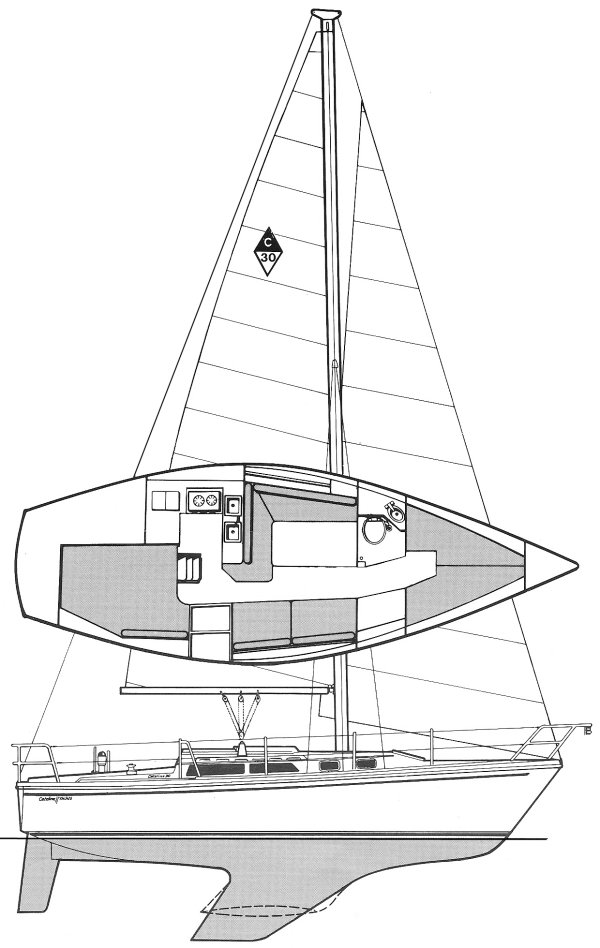
Use the form below to contact us!
- Articles and Guides
Catalina 30 Review: Features, Performance and Tech Specs
7th feb 2024 by john burnham / samantha wilson.

The Catalina 30 has had a long and illustrious life and remains to this day a favorite on the used market. Over 6,400 Catalina 30s were sold during its 25-year production run starting in 1974, testament to its solid construction, functional layout, ease of sailing, a modest price, and the strong Catalina dealer network.
So what makes it so popular? While it’s not really intended as a bluewater cruiser, the Catalina 30 handles coastal and inshore sailing with ease. It is ideal for weekends or week-long cruises thanks to its cleverly thought-out interior space. Overall, the Catalina 30 sails well, is a stable design in stiffer winds, and can be sailed single-handedly by a competent skipper.
Despite several versions throughout its production run, including the MKII, first built in 1986, and the MKIII, in 1994, the basic dimensions of the model remained unchanged: LOA 29’11", beam 10’10", displacement 10,200 lbs., and standard draft 5’3". Likewise, the interior was never altered. Catalina’s approach to the huge success of the 30 seemed to be ‘if it ain’t broke, don’t fix it!’.
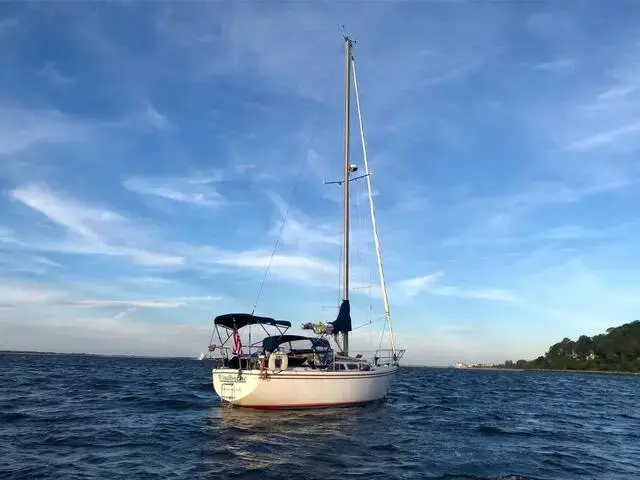
Catalina 30. Rightboat seller photo.
Catalina 30 Key Features
There have been many versions of the Catalina 30 throughout its long production run, with different configurations. There have been standard and tall rigs, each with a bowsprit option, as well as shoal, wing, and deep fin keels. Following on from the MKII in 1986, the MKIII in 1994 made some noticeable changes, namely a slight widening of the hull aft, which allowed for a transom boarding platform.
The Catalina 30’s hull, like all of Catalina’s models, is built of fiberglass and polyester resin, with a deck constructed of either balsa or plywood between fiberglass laminates. Belowdecks, the Catalina 30s layout remained unchanged throughout its life. With a wide companionway creating a spacious feel to the cabin, able to accommodate up to four with a separate head, large galley, and cozy saloon, it proved popular and user-friendly. The boat has an aft cockpit with a closed transom.
While this model undoubtedly ticked a lot of boxes for many sailors, it had a few common problems, as described in various owners forums. Compression fatigue at the maststep on deck and in the bilge under the compression post has been commonly reported over the years and may need to be fixed. Likewise, old wooden spreaders sometimes fail, and leaks and separation may be experienced at the keel-to-hull joint. Ensuring these are all inspected in a thorough marine survey when buying will highlight any issues the boat might have.
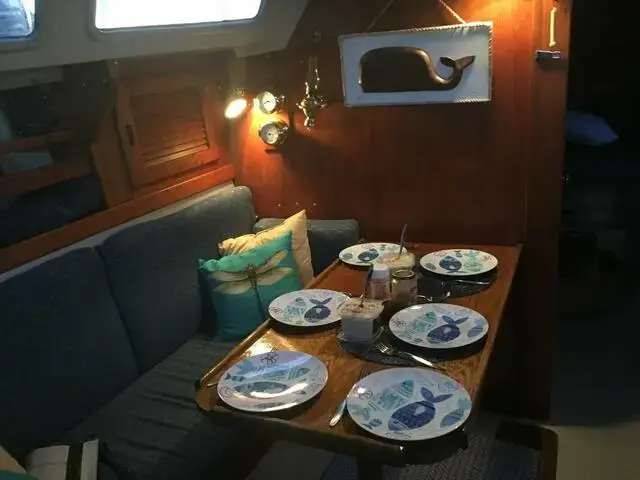
Catalina 30s spacious interior with separate cabin and dinette. Rightboat seller photo.
Catalina 30 Performance
The Catalina 30 impressively straddles the line between performance and comfort, offering decent speeds compared to competitors of the same era, despite a lower sail/displacement ratio of 15.22. The fin keel version has deeper draft, lowering the center of gravity and providing better performance upwind. A higher ballast/displacement ratio means the Catalina 30 stands up well in stronger winds.
Catalina 30 Why Buy It
- One of the top-selling 30-foot sailboats ever
- Spacious accommodation for up to 4 people including saloon and galley
- Wide, deep hull creates exceptional space above and below decks
- Known for its stability under sail
- Variety of models and variations to be found on the used market
- Good value for money on the used market with lots in circulation
- Buying used?: Possibly compromised deck cores and mast steps merit checking before purchase. For other tips when buying a used boat, read our Boat Inspection Checklist
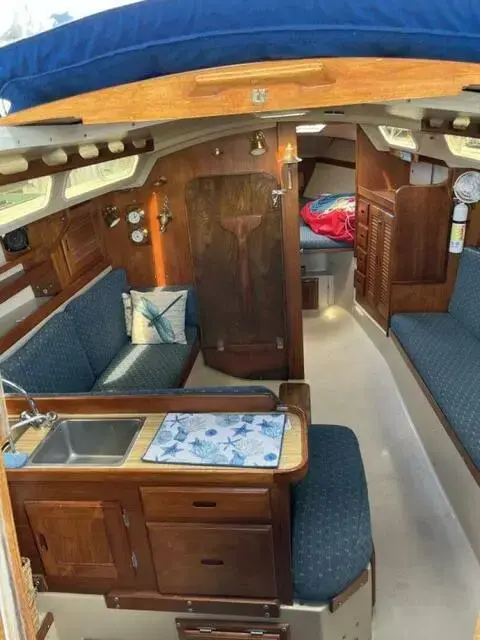
Galley and saloon of Catalina 30. Rightboat seller photo.
Catalina 30 Technical Specifications
- LOA: 29.92 ft
- Beam: 10.83 ft
- Draft: 5.25 ft
- Rigging Type: Masthead sloop
- Hull type: Fin w/spade rudder
- Displacement: 10200.78 lbs
- Ballast: 4200 lbs
- Ballast type: Lead
- Fuel tank capacity: 21 gallons
- Sail area/displacement ratio: 15.22
- Ballast/displacement ratio: 41.18
- Critical hull speed: 6.70 knots
- Engines (after mid-1980s): 3-cylinder Universal M-25 diesel engine

Enclosed cockpit and seating of Catalina 30. Rightboat seller photo.
Check out all the Catalina boats for sale
Written By: John Burnham / Samantha Wilson
John Burnham is a marine editor and writer with decades of journalism experience as Chief Editor of boats.com, Sailing World, Cruising World, and other boating websites. As a competitive sailor, he has led teams to world and national titles in the International One-Design, Shields, and other classes. Based in Newport, Rhode Island, John is a PCC leadership coach, a member of the America’s Cup Hall of Fame Selection Committee, and a past board member of Sail America and US Sailing. For more, see johnsburnham.com .
Samantha Wilson has spent her entire life on and around boats, from tiny sailing dinghies all the way up to superyachts. She writes for many boating and yachting publications, top charter agencies, and some of the largest travel businesses in the industry, combining her knowledge and passion of boating, travel and writing to create topical, useful and engaging content.
More from: John Burnham / Samantha Wilson
Related Articles and Guides
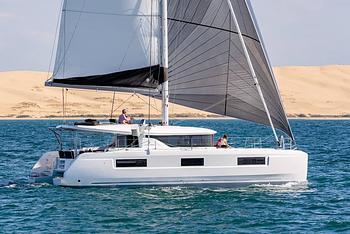
31st Mar 2024
Lagoon 46 Review, Spacious Bluewater Catamaran
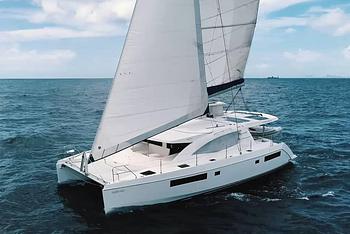
21st Mar 2024
Leopard 48 Review: Features, Performance and Tech Specs
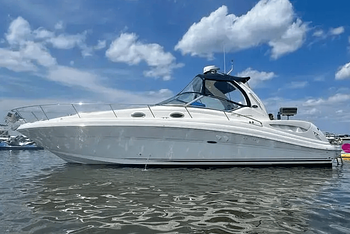
13th Mar 2024
Sea Ray 340 Sundancer Review, an Iconic Cabin Cruiser
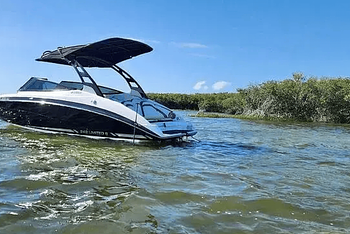
29th Feb 2024
Yamaha 242 Limited S Review: Features, Performance and Tech Specs
- Explore Rightboat
- Boats for Sale
- Boating Articles
- Buyers Guide
- About RightBoat
- Sell Your Boat
- Boat Selling Advice
Enter your email to keep up to date with the latest news
Join for free
Sign up now for free and discover how easy it is to keep up to date with THE latest boats for sale. Find your right boat, and tailor your voyage to finding your next boat.
Benefits of becoming a member:
- Set up tailored alerts
- Personalise your experience
- Download full specifications and broker details
- Keep tabs on your favourite boats
Are you a broker? Join as a Broker
Rightboat - join for free.
Do you have an account already? Login
Save this search
Save your search and receive new boats in your email..
You can unsubscribe from your alerts whenever you like. By pressing the button you accept the Legal Terms and conditions
Great choice! Your favorites are temporarily saved for this session. Sign in to save them permanently, access them on any device, and receive relevant alerts.
- Sailboat Guide
Catalina 30 MKII
Catalina 30 MKII is a 29 ′ 11 ″ / 9.1 m monohull sailboat designed by Gerry Douglas and built by Catalina Yachts between 1986 and 1991.

- 1 / 20 Fairhope, AL, US 1987 Catalina 30 MKII $27,000 USD View
- 2 / 20 Daytona Beach, FL, US 1987 Catalina 30 MKII $13,500 USD View
- 3 / 20 Fairhope, AL, US 1987 Catalina 30 MKII $27,000 USD View
- 4 / 20 Daytona Beach, FL, US 1987 Catalina 30 MKII $13,500 USD View
- 5 / 20 Fairhope, AL, US 1987 Catalina 30 MKII $27,000 USD View
- 6 / 20 Fairhope, AL, US 1987 Catalina 30 MKII $27,000 USD View
- 7 / 20 Daytona Beach, FL, US 1987 Catalina 30 MKII $13,500 USD View
- 8 / 20 Fairhope, AL, US 1987 Catalina 30 MKII $27,000 USD View
- 9 / 20 Daytona Beach, FL, US 1987 Catalina 30 MKII $13,500 USD View
- 10 / 20 Fairhope, AL, US 1987 Catalina 30 MKII $27,000 USD View
- 11 / 20 Fairhope, AL, US 1987 Catalina 30 MKII $27,000 USD View
- 12 / 20 Daytona Beach, FL, US 1987 Catalina 30 MKII $13,500 USD View
- 13 / 20 Fairhope, AL, US 1987 Catalina 30 MKII $27,000 USD View
- 14 / 20 Daytona Beach, FL, US 1987 Catalina 30 MKII $13,500 USD View
- 15 / 20 Fairhope, AL, US 1987 Catalina 30 MKII $27,000 USD View
- 16 / 20 Daytona Beach, FL, US 1987 Catalina 30 MKII $13,500 USD View
- 17 / 20 Daytona Beach, FL, US 1987 Catalina 30 MKII $13,500 USD View
- 18 / 20 Daytona Beach, FL, US 1987 Catalina 30 MKII $13,500 USD View
- 19 / 20 Daytona Beach, FL, US 1987 Catalina 30 MKII $13,500 USD View
- 20 / 20 Daytona Beach, FL, US 1987 Catalina 30 MKII $13,500 USD View
Rig and Sails
Auxilary power, accomodations, calculations.
The theoretical maximum speed that a displacement hull can move efficiently through the water is determined by it's waterline length and displacement. It may be unable to reach this speed if the boat is underpowered or heavily loaded, though it may exceed this speed given enough power. Read more.
Classic hull speed formula:
Hull Speed = 1.34 x √LWL
Max Speed/Length ratio = 8.26 ÷ Displacement/Length ratio .311 Hull Speed = Max Speed/Length ratio x √LWL
Sail Area / Displacement Ratio
A measure of the power of the sails relative to the weight of the boat. The higher the number, the higher the performance, but the harder the boat will be to handle. This ratio is a "non-dimensional" value that facilitates comparisons between boats of different types and sizes. Read more.
SA/D = SA ÷ (D ÷ 64) 2/3
- SA : Sail area in square feet, derived by adding the mainsail area to 100% of the foretriangle area (the lateral area above the deck between the mast and the forestay).
- D : Displacement in pounds.
Ballast / Displacement Ratio
A measure of the stability of a boat's hull that suggests how well a monohull will stand up to its sails. The ballast displacement ratio indicates how much of the weight of a boat is placed for maximum stability against capsizing and is an indicator of stiffness and resistance to capsize.
Ballast / Displacement * 100
Displacement / Length Ratio
A measure of the weight of the boat relative to it's length at the waterline. The higher a boat’s D/L ratio, the more easily it will carry a load and the more comfortable its motion will be. The lower a boat's ratio is, the less power it takes to drive the boat to its nominal hull speed or beyond. Read more.
D/L = (D ÷ 2240) ÷ (0.01 x LWL)³
- D: Displacement of the boat in pounds.
- LWL: Waterline length in feet
Comfort Ratio
This ratio assess how quickly and abruptly a boat’s hull reacts to waves in a significant seaway, these being the elements of a boat’s motion most likely to cause seasickness. Read more.
Comfort ratio = D ÷ (.65 x (.7 LWL + .3 LOA) x Beam 1.33 )
- D: Displacement of the boat in pounds
- LOA: Length overall in feet
- Beam: Width of boat at the widest point in feet
Capsize Screening Formula
This formula attempts to indicate whether a given boat might be too wide and light to readily right itself after being overturned in extreme conditions. Read more.
CSV = Beam ÷ ³√(D / 64)
(1986-1991) Among changes were ‘T’ cockpit, slightly different deck and liner, and different Engine options. A wing keel version was available,(hull #500+) as was a tall rig. Wing keel: DRAFT: 1.17m/3.83’. BALLAST: 4300lbs/1950kg DISPLACEMENT: 10,300lbs/4672kg TALL RIG: I: 43.00’/13.11m J: 13.16’/4.01m P: 37.00’/11.28m E: 12.00’/3.66m Sail Area(100%): 504.94 ft2/46.91 m2
Embed this page on your own website by copying and pasting this code.

Discover Related Sailboats

Catalina 30
- About Sailboat Guide
©2024 Sea Time Tech, LLC
This site is protected by reCAPTCHA and the Google Privacy Policy and Terms of Service apply.
- New Sailboats
- Sailboats 21-30ft
- Sailboats 31-35ft
- Sailboats 36-40ft
- Sailboats Over 40ft
- Sailboats Under 21feet
- used_sailboats
- Apps and Computer Programs
- Communications
- Fishfinders
- Handheld Electronics
- Plotters MFDS Rradar
- Wind, Speed & Depth Instruments
- Anchoring Mooring
- Running Rigging
- Sails Canvas
- Standing Rigging
- Diesel Engines
- Off Grid Energy
- Cleaning Waxing
- DIY Projects
- Repair, Tools & Materials
- Spare Parts
- Tools & Gadgets
- Cabin Comfort
- Ventilation
- Footwear Apparel
- Foul Weather Gear
- Mailport & PS Advisor
- Inside Practical Sailor Blog
- Activate My Web Access
- Reset Password
- Customer Service

- Free Newsletter

What You Can Learn on a Quick Test Sail

Cabo Rico’s Classic Cutter

Bob Perrys Salty Tayana 37-Footer Boat Review

Tartan 30: An Affordable Classic

Preparing Yourself for Solo Sailing

Your New Feature-Packed VHF Radio

Preparing A Boat to Sail Solo

Solar Panels: Go Rigid If You have the Space…

When Should We Retire Dyneema Stays and Running Rigging?

Rethinking MOB Prevention


Top-notch Wind Indicators

The Everlasting Multihull Trampoline

Taking Care of Your 12-Volt Lead-Acid Battery Bank

Hassle-free Pumpouts

What Your Boat and the Baltimore Super Container Ship May Have…

Check Your Shorepower System for Hidden Dangers

Waste Not is the Rule. But How Do We Get There?

How to Handle the Head

The Day Sailor’s First-Aid Kit

Choosing and Securing Seat Cushions

How to Select Crew for a Passage or Delivery

Re-sealing the Seams on Waterproof Fabrics

Waxing and Polishing Your Boat

Reducing Engine Room Noise

Tricks and Tips to Forming Do-it-yourself Rigging Terminals

Marine Toilet Maintenance Tips

Learning to Live with Plastic Boat Bits
- Belowdecks & Amenities
- Boat Maintenance
- Sailboat Reviews
- Sails, Rigging & Deck Gear
- Systems & Propulsion
Improve Your Catalina 30: Upgrading the World’s Most Popular 30-Footer
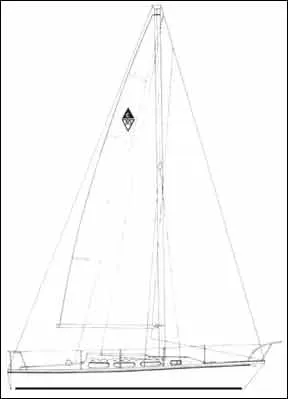
The Catalina 30 is a remarkable success story. We suspect that more Catalina 30s have been built than any other boat of that size anywhere in the world. While the basic boat has remained unchanged since it was introduced in 1975, there have been dozens, perhaps even hundreds, of minor developments in the boat in the course of a production run that is approaching 4,000 hulls.
The advantage of a boat in production for so long is a high degree of product refinement over the years. The challenge for the owner of an early version of the boat is to upgrade his boat to the standards of models currently in production.
In the case of the Catalina 30, a number of bulletins have been published by the builder over the years, detailing improvements to the boat. In addition, there is an active owners’ association, and many individual owners have embarked on significant programs of upgrading their boats.
As a rule, the changes to the boat over the years of production have been true improvements. At least one change, however, was less successful. The original changeover to diesel power resulted in a boat that was significantly underpowered, according to many owners.
Almost all the suggestions presented here for the upgrading of the Catalina 30 come from owners. Over 80 responded to the detailed questionnaire about the boat, and many added more pages of comments to the responses. The owners responding own boats that run the gamut of the production history of the Catalina 30, from hull number 2 to hull numbers well over 3,000!
Here, then are the suggestions of Catalina 30 owners for the improvement of the world’s most popular 30-footer. Not all will be applicable to any particular hull. Many of the changes suggested or performed by owners of early boats were incorporated into the production of later boats. In addition, some of the changes became factory retrofits, so that some older boats have been upgraded to the specifications of newer models.
Hull and Construction Details
Until very recently, all through hulls in the boat below the waterline consisted of gate valves screwed onto pipes fiberglassed into the hull. Current models utilize RC synthetic seacocks incorporating recessed through hull fittings.
The advantage of the old system is that there is no exposed, drag-inducing external skin fitting. The disadvantage is that gate valves are a generally poor substitute for seacocks, since it is not always possible to determine if they are open or closed, they can be jammed in the open position by debris, and they are as a rule more subject to corrosion.
Replacement of the gate valves with proper seacocks, either of tapered plug or ball valve construction, is recommended. Proper skin fittings should be installed at the same time, and these can either be faired in externally, or recessed (see Better Boat, February 1984).
As a rule, deck hardware is installed with large washers, but without proper backup plates. Stanchions, pulpits, and cleats can be made stronger by the addition of aluminum backup plates to help distribute load.
Like many other builders, Catalina has finally abandoned running lights mounted in the topsides. If being seen at night is a priority, install a pulpit-mounted combination running light, as is used in current production models of the Catalina 30.
Generally a little more attention to bottom detailing on the Catalina 30 should get you a little more speed. The rather large gap between the skeg and rudder should be filled in with fairing flaps to reduce crossflow. This improvement, suited to many boats, will be detailed in a future issue. In addition, lines and seaweed can jam between the forward part of the rudder blade and the bottom of the skeg. A deflecting rod, perhaps a piece of 5 11 6″ diameter bronze rod, can be glassed into the bottom of the skeg, just overlapping the opening between the rudder blade and the bottom of the skeg. In New England, this type of rudder/skeg configuration, without the deflector, is known as a potcatcher because of the amount of lobster pot warp that can lodge in the opening.
Prop skeg configuration has changed slightly over the years, but as a rule, the skegs are fairly clean airfoil bronze castings. On the new Catalina 30s we examined, the casting was quite rough, however, and would benefit from a touchup coat of epoxy and microballoons, followed by a thorough sanding to smooth it out.
Prop wash when under power can make the Catalina 30 a bear to handle for extended periods. The original rudder was redesigned, and many older boats have been retrofitted with the improved rudder which greatly reduced the helm problem. If you bought your Catalina 30 used, and find the helm excessively heavy when powering, contact Catalina for information on the new rudder. If in doubt, send a photograph of your rudder to the company. Theyll tell you whether you have the new or old version.
Rig The rig of the Catalina 30 is decidely old fashioned, with its untapered mast tube, wooden spreaders, and unanodized mast and boom. Mast and boom should be painted, both to reduce surface oxidation and improve appearance.
Standing rigging, chainplates, and rigging fittings bring negative comments from a surprising number of owners, who consider this part of the boat a weak point. Beef-up kits for lower shrouds are available from the builder at nominal cost, and most older boats have had this modification If you have an older boat and don’t know, compare your boat to a recent model nearby or take a picture and send it to the builder.
If you have closed body, stainless steel turnbuckles, replace them with open body turnbuckles of bronze, chromed bronze, or mixed bronze/stainless steel construction. Steel on steel turnbuckles have a nasty habit of seizing, and the closed body makes its difficult to judge the amount of adjustment left in the screw.
The small diameter wire used for shrouds and stays stretches excessively, according to some owners, making it difficult to maintain headstay tension. Going up one wire diameter, at least on forestay and backstay, is suggested by many owners.
Although it is rarely mentioned by owners, we would suggest replacing the wooden spreaders with airfoil aluminum spreaders.
Internal halyards, led aft along the cabin top to the cockpit, are a popular modification. There is just enough room between the forward edge of the seahood and the cabintop handrail to put turning blocks on the deck for the halyards. Be sure to stagger the halyard exit holes on the mast, and fit them with chafe guards to keep the halyard wires from eating into the mast tube.
The boat quickly develops weather helm as it heels, a not uncommon trait of wide boats such as the Catalina 30. Even sailing upright on a broad reach, there is a fair amount of weather helm. This is minimized with the tall rig/bowsprit option, and can be reduced on the standard rig by raking the mast forward slightly, and having the mainsail cut with minimum roach. Unfortunately, reducing the roach gives away sail area that the boat may need in light air. We see no reason why the bowsprit couldnt be added to the standard rig boat to move the center of effort of the sail plan further forward. This will, of course, increase the boats rating under any racing rule.
Although the shrouds are set well inboard, the genoa track is mounted atop the toerail. This may be fine for reaching, but it leaves too wide a sheeting angle for going upwind, according to owners. Installing a genoa track inboard, between the stanchions and the cabin trunk, would decrease the sheeting angle by about 5 , and significantly improve windward performance. It may be necessary to install foot blocks at the aft end of the existing genoa track to get a good lead to the sheet winches, but this inboard track could probably be used with the working jib as well, which has a poor lead to the jibsheet winches without leading the sheet through a second block on the outboard track.
Traveler location is problematic. At the aft end of the cockpit, the lead to the boom is poor, and the mainsheet can pose a problem when jibing, according to owners. Locating the traveler forward, over the companionway, both interferes with the companionway and complicates the installation of a dodger.
As on most boats, we suggest the installation of the largest self-tailing jibsheet winches that will fit atop the coamings. Overkill is a nonexistent word when it comes to handling headsail sheets, and the self-tailer is the only way to go. Once youve tried them, youll never go back.
Engine and Installation Over the years, five different engines have been used in the Catalina 30: the workhorse Atomic Four gasoline engine, and the Universal 5411, Yanmar YSB12, Universal Model 18, and Universal Model 25 diesels. The engine compartment was designed for the Atomic Four. Some of the diesels present a tight fit.
According to owners, boats equipped with the Yanmar YSB12. and Universal 5411 diesels are underpowered. The current Universal Model 18 is only slightly larger. The two most desirable engines are the Universal Model 25 and the Atomic Four.
The Atomic Four is relatively quiet and powerful. All of the diesels are more noisy, and with the exception of the Model 25, much less powerful. If youre going to repower, go to the Universal Model 25. Slight modification of the hatch under the port settee will be required to fit the diesel, which is about 3 taller than the Atomic Bomb, as it is affectionately known.
If you can possibly manage it -and space is at a premium here -try to fit some sound insulation in the engine compartment, as the boat is noisy below underway with any of the diesels.
Since the prop installation is exposed, the boat could benefit from a folding or feathering prop. Since we have experienced a slight loss in speed and power with most folding proprs, don’t do it unless you have one of the larger engines. As a rule, we prefer the feathering Max-prop to a folding prop because it generates equal thrust in both reverse and forward, unlike most folding props. Watch the tip clearance carefully, as there isn’t much room here.
If you have a 25 amp alternator and dual batteries, you should switch to a larger, 55 amp alternator. According to owners, this is a simple adaptation.
While dual batteries have always been optional, most boats are equipped with them. If yours isn’t, do it. If the batteries are in the original port side location, shift them to the starboard side, under the chart table. This will eliminate the slight port list found in some older boats.
Comfort and Convenience
Ventilation is a problem on older boats. According to many owners, the sliding port in the head leaks, and there is no provision for ventilation in bad weather. The forward-sloping bulkhead between the cockpit and the main cabin makes it impossible to leave a hatch board out in rain or heavy weather.
Opening cabintop ventilation hatches over the head and forward end of the main cabin, as found on new versions of the boat, can be easily installed on older boats.
A cockpit dodger makes it possible to leave the hatch open in bad weather but makes access to the mainsheet a problem if the hatch-mounted traveler is installed. If you don’t want a dodger, and havent led the halyards aft along the cabin trunk, cowl vents in Dorade boxes on either side of the cabintop at its aft end will provide ventilation with the main hatch shut off.
The strong taper of the sides of the companionway, coupled with the fairly narrow internal and external teak pieces which hold the drop boards, strikes us as a serious weak point. While modification of the hatch, which we feel is just too big for offshore use, may not be practical, theres no reason that the teak retainers for the drop boards can’t be made an inch wider, both inside and outside. This would mean youd have to lift the boards further to either remove them or install them, but it would also make them more secure in a knockdown.
Modifications belowdecks are as many and varied as the personalities of the owners. As a rule, most Catalina 30s from all years suffer from inadequate division of storage spaces. Vertical dividers in the galley storage spaces behind the stove would greatly increase the practicality of that storage area.
Several other galley improvements will pay dividends. While the two galley sinks help give the Catalina 30 the feel of a big boat, the outboard sink, according to owners, can flood back through the drain if the boat is well heeled on starboard tack. Wed eliminate the outboard sink, fitting a dry well for storage instead. The inboard sink probably can’t flood under most sailing conditions, so the sink drain can then be left open for use.
Owners report mediocre icebox insulation, particularly on older models. Some owners merely stuff fiberglass house insulation between the outside of the icebox and the hull, but a far more effective solution is to glue on sheet urethane.
Older boats have no insulation in the icebox lid. This can be corrected by gluing sheet urethane to the underside of the hatch, fitting as closely to the sides of the hatch as possible to still give clearance on the inside. The sheet urethane can be glassed over directly. Dont use Styrofoam -its less efficient -and don’t glass over it, if you do. It will dissolve in polyester resin. Even the insulated hatches on new versions of the boat need improved gasketing between lid and icebox to reduce heat intrusion.
The chart table has been improved on new models by making it flat, rather than angled. Angled chart tables only work when they are mounted athwartships, rather than fore and aft. Theres no reason older tables can’t be modified in the same way. While youre at it, add drop leaves to the fore and aft ends of the table to increase the working surface, and make the fiddles removable so you can use all the surface.
If the boat is to be used for any serious cruising, consider replacing the standard alcohol stove with a gas stove. CNG is offered as an option on new boats, and it will greatly increase the livability of older boats. We guarantee that the improved performance of the cook will make this a worthwhile change every time.
Your cruising will be more comfortable if you add an extra water tank under the forward cabin berth. This has become a standard option on new boats, and is an easy retrofit in older boats. Do not, however, keep this tank full for daysailing or day racing, as the weight this far forward will accentuate pitching moment.
Conclusions
The Catalina 30 comes as a fairly well equipped basic boat. However, the responses of owners indicate that a lot of customizing can significantly improve the boats function.
Because there are so many Catalina 30s in the world, it has probably been the subject of more minor modification than any other 30-footer. The changes suggested here are by no means all the modifications that owners have made. Rather, they are either the most common ones, or the ones we feel do the most to make the boat easy to sail and easy to live with.
Every boat is a compromise, from the moment it leaves the designers drawing board until the end of its life. With a lot of thought, some money, and a fair amount of thoroughly enjoyable labor, you can improve any boat. And the Catalina 30 must surely be one of the most thoroughly owner-improved boats in the history of boat-building.
RELATED ARTICLES MORE FROM AUTHOR
You guys use a spell checker? I can see a dictionary not having some of the nautical terms, but you forgot the apostrophe on LOTS of words like theyll isnt LOL
Great, comprehensive article. You’ve given me a good laundry list to add to my existing projects!
How to make curtains for the Catalina 30? Help! Please!
does any one what the shift cable length is on a Catalina 30 with Edson pedestal
Very interesting info. I have a 1979 tall rig 30 ft catalina and looking for the Tensions on the rigging, especially the Lower afts. If anyone can suggest where this is listed, It would be appreciated
LEAVE A REPLY Cancel reply
Log in to leave a comment
Latest Videos

Buying A Sailboat Is Scary! Yacht Broker Interview

The Great Loop – The Basics

Bottom Paint Showdown – Six Paints, One Winner!

Tartan 30 | Boat Review
- Privacy Policy
- Do Not Sell My Personal Information
- Online Account Activation
- Privacy Manager
International Catalina 30/309 Association
Home of the Catalina 30 and 309 Community
Welcome to IC30A

The International Catalina 30 Association was established in 1974 for furthering the enjoyment of ownership of a Catalina 30/309 and to promote a community of enthusiasts of one of the most successful yachts built in America.
The Association is supported by Catalina Yachts and publishes articles of interest to members in the “ Mainsheet ” magazine. The specific goals are to:
- provide the Catalina owners magazine “Mainsheet” to its members;
- co-ordinate and promote cruising and social activities;
- provide sources of information for maintenance and care of the Catalina 30;
- promote the education of safe boating; and
- co-operate with other yachting organizations.
We hope you will find everything about the Catalina 30 and cousin C309 on this site. Please make this page your favorite bookmark and visit often for the latest.
Becoming a member or renewing your membership Membership in IC30A has additional advantages. Learn how easy and inexpensive it is to Join our association. Joining the association will be the best thing you can do for yourself and to keep the C30/C309 alive !!
Technical Library and C30 Owners Forum See all the frequently asked questions in the tech Library! C30 FAQs, if what you need is not posted there, you can join the C30/309 forum to discuss problems, solutions, upgrades, modifications, cruising, racing and other boating issues.
Contribute to the Mainsheet Newsletter
Let us hear from the owners! We need articles for the Mainsheet and any sailing, repair, mods, fixes to your boats. Lets share with other boat owners.
Capri 30 catalina
The capri 30 catalina is a 29.5ft masthead sloop designed by f. butler and built in fiberglass by catalina yachts since 1982..
The Capri 30 catalina is a light sailboat which is a very high performer. It is very stable / stiff and has a low righting capability if capsized. It is best suited as a racing boat.
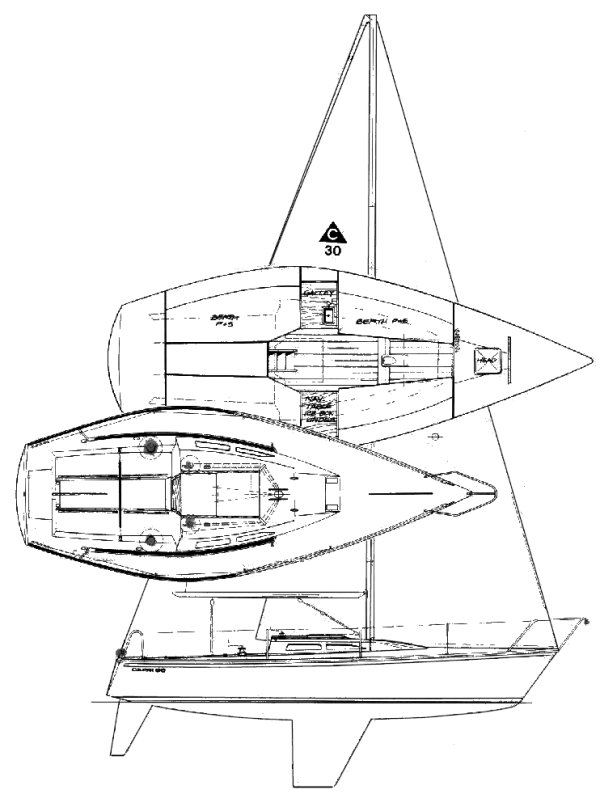
Capri 30 catalina for sale elsewhere on the web:

Main features
Login or register to personnalize this screen.
You will be able to pin external links of your choice.

See how Sailboatlab works in video

We help you build your own hydraulic steering system - Lecomble & Schmitt
Accommodations
Builder data, modal title.
The content of your modal.
Personalize your sailboat data sheet

IMAGES
VIDEO
COMMENTS
Notes. With more than 6000 sold, the Catalina 30 is one of the most successful production sailing yachts in history. During the long production run of this basic model there were a great number of variations with standard and tall rig configurations, each with a bowsprit option, and also including shoal, wing and deep fin keels.
Blue Water Surf Value Rank (BWSVR) 4127. Capsize Comfort Value Rank (CCVR)
Catalina 30 is a 29 ... Source: sailboatdata.com / CC BY. Embed Embed. View Demo. Embed this page on your own website by copying and pasting this code. For Sale View More . South Haven, MI, US 1977 Catalina Catalina 30 $7,800 USD ...
The Catalina 30 is a 29.92ft masthead sloop designed by Frank Butler and built in fiberglass by Catalina Yachts between 1976 and 2008. 6430 units have been built. The Catalina 30 is a moderate weight sailboat which is slightly under powered. It is very stable / stiff and has a low righting capability if capsized. It is best suited as a coastal ...
Catalina 30 Mark II. This model was built between 1986-1991 and was designed by Gerry Douglas. Improvements include a T-shaped cockpit and a new deck and liner design. It has a length overall of 29.92 ft (9.1 m), a waterline length of 25.00 ft (7.6 m), displaces 10,200 lb (4,627 kg) and carries 4,200 lb (1,905 kg) of lead ballast.
The Catalina 30 mkiii is a 29.92ft masthead sloop designed by Gerry Douglass and built in fiberglass by Catalina Yachts between 1990 and 2008. The Catalina 30 mkiii is a moderate weight sailboat which is slightly under powered. It is very stable / stiff and has a low righting capability if capsized. It is best suited as a coastal cruiser.
The Catalina 30 mkii is a 29.92ft masthead sloop designed by Gerry Douglass and built in fiberglass by Catalina Yachts between 1986 and 1991. The Catalina 30 mkii is a moderate weight sailboat which is slightly under powered. It is very stable / stiff and has a low righting capability if capsized. It is best suited as a coastal cruiser.
The Catalina 30 impressively straddles the line between performance and comfort, offering decent speeds compared to competitors of the same era, despite a lower sail/displacement ratio of 15.22. The fin keel version has deeper draft, lowering the center of gravity and providing better performance upwind. A higher ballast/displacement ratio ...
Catalina 30 MKIII is a 29′ 11″ / 9.1 m monohull sailboat designed by Gerry Douglas and built by Catalina Yachts between 1990 and 2008. Great choice! Your favorites are temporarily saved for this session. ... Source: sailboatdata.com / CC BY. Embed Embed. View Demo. Embed this page on your own website by copying and pasting this code.
Catalina 30 MKII is a 29 ... Source: sailboatdata.com / CC BY. Embed Embed. View Demo. Embed this page on your own website by copying and pasting this code. For Sale View More . Fairhope, AL, US 1987 CATALINA 30 MK II $27,000 USD. Daytona Beach, FL, US ...
Catalina 30 represents the culmination of a dream to possess a comfortable, able, blue water cruising yacht. Others appreciate the Catalina 30's proven race winning capability and outstanding performance. However you intend to use your Catalina you can be confident she was built by those who understand the demands of the sea.
September 1990-Catalina 30 hull number 6,000 is completed, setting a new keel-boat production record. July 1991-The first Catalina 28 is built. August 1991-Catalina's Morgan Division completes Procyon, a 65-foot test boat for new concepts in yacht design and construction for Olaf Harken and Procyon Inc.
Complete Sail Plan Data for the Catalina 30 Standard Sail Data. Sailrite offers free rig and sail dimensions with featured products and canvas kits that fit the boat. ... Sailboat Data ; Catalina 30 Standard Sail Data ; Catalina 30 Standard Sail Data. Pinit. SKU: X-SD-4193 . Quantity discounts available . Quantity Price; Quantity -+ Add to Cart ...
Hull# 5820+. A wing keel version was available, as was a tall rig. Wing keel draft: 1.17m 3.83′. Last Catalina 30 was built in 2008. (from CATALINA MKII): Re-designed cockpit and open transom. Updated galley. Topside windows. The photo above was taken from the cover of the C30 MKIII brochure, sent to us by Ken […]
20 to 30 indicates a coastal cruiser; 30 to 40 indicates a moderate bluewater cruising boat; 40 to 50 indicates a heavy bluewater boat; over 50 indicates an extremely heavy bluewater boat. Comfort ratio = D ÷ (.65 x (.7 LWL + .3 LOA) x Beam^1.33), where displacement is expressed in pounds, and length is expressed in feet.
The Catalina 30 is a remarkable success story. We suspect that more Catalina 30s have been built than any other boat of that size anywhere in the world. While the basic boat has remained unchanged since it was introduced in 1975, there have been dozens, perhaps even hundreds, of minor developments in the boat in the course of a production run ...
The International Catalina 30 Association was established in 1974 for furthering the enjoyment of ownership of a Catalina 30/309 and to promote a community of enthusiasts of one of the most successful yachts built in America. The Association is supported by Catalina Yachts and publishes articles of interest to members in the " Mainsheet ...
The Catalina 30 wbowsprit is a 29.92ft masthead sloop designed by Frank Butler and built in fiberglass by Catalina Yachts since 1972. The Catalina 30 wbowsprit is a moderate weight sailboat which is a reasonably good performer. It is very stable / stiff and has a low righting capability if capsized. It is best suited as a coastal cruiser.
1980 30' Catalina sloop rigged, fin keel vessel is solid throughout, fully operational & easy to sail. Set up for long distance sails or dockside home. Lots of perks and pluses. Price. $14,900. Built. 1980. Location. Key West, FL.
The technical storage or access is strictly necessary for the legitimate purpose of enabling the use of a specific service explicitly requested by the subscriber or user, or for the sole purpose of carrying out the transmission of a communication over an electronic communications network.
The Capri 30 catalina is a 29.5ft masthead sloop designed by F. Butler and built in fiberglass by Catalina Yachts since 1982. The Capri 30 catalina is a light sailboat which is a very high performer. It is very stable / stiff and has a low righting capability if capsized. It is best suited as a racing boat.
20 to 30 indicates a coastal cruiser; 30 to 40 indicates a moderate bluewater cruising boat; 40 to 50 indicates a heavy bluewater boat; over 50 indicates an extremely heavy bluewater boat. Comfort ratio = D ÷ (.65 x (.7 LWL + .3 LOA) x Beam^1.33), where displacement is expressed in pounds, and length is expressed in feet.
The CATALINA 22 is one of the most popular sailboats ever in anything close to this size,. 15,000 boats sold (2009) It has been built in different plants around the world..(Known in Australia as the BOOMAROO 22.) A fixed keel version introduced in the early 1970's Draft: 3.5ft; Displacement: 2,490 lbs.; Ballast: 800 lbs. A […]